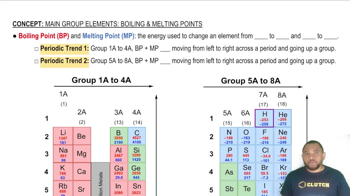(a) Read the following description of the element zinc and indicate which are physical properties and which are chemical properties. Zinc melts at 420 °C. When zinc granules are added to dilute sulfuric acid, hydrogen is given off and the metal dissolves. Zinc has a hardness on the Mohs scale of 2.5 and a density of 7.13 g/cm3 at 25 °C. It reacts slowly with oxygen gas at elevated temperatures to form zinc oxide, ZnO.
Ch.1 - Introduction: Matter, Energy, and Measurement

Brown14th EditionChemistry: The Central ScienceISBN: 9780134414232Not the one you use?Change textbook
Chapter 1, Problem 21c,d,e
Label each of the following as either a physical process or a chemical process: (c) melting a piece of chocolate (d) burning fossil fuel (e) discharging a battery.
 Verified step by step guidance
Verified step by step guidance1
Understand the difference between physical and chemical processes: A physical process involves changes in the state or appearance of a substance without altering its chemical composition, while a chemical process involves a change in the chemical composition of the substance.
Identify the process in question: The problem asks about melting a piece of chocolate.
Consider what happens during melting: When chocolate melts, it changes from a solid to a liquid state.
Determine if the chemical composition changes: During melting, the chemical structure of chocolate remains the same; only its physical state changes.
Conclude the type of process: Since melting involves a change in state without altering the chemical composition, it is a physical process.

Verified video answer for a similar problem:
This video solution was recommended by our tutors as helpful for the problem above.
Video duration:
1mWas this helpful?
Key Concepts
Here are the essential concepts you must grasp in order to answer the question correctly.
Physical Process
A physical process involves changes in the state or appearance of a substance without altering its chemical composition. Examples include phase changes like melting, freezing, and boiling, where the substance retains its original chemical identity despite changes in form.
Recommended video:
Guided course

Physical Properties
Chemical Process
A chemical process involves a transformation that alters the chemical composition of a substance, resulting in the formation of new substances. This includes reactions such as combustion, oxidation, and synthesis, where the original materials undergo a chemical change.
Recommended video:
Guided course

Chemical Properties Example
Melting
Melting is the transition of a substance from a solid to a liquid state due to the absorption of heat. In the case of chocolate, melting occurs when heat breaks the intermolecular forces holding the solid structure together, allowing the chocolate to flow while maintaining its chemical identity.
Recommended video:
Guided course

Boiling Point and Melting Point
Related Practice
Textbook Question
865
views
Textbook Question
(b) Which properties of zinc can you describe from the photo? Are these physical or chemical properties?
511
views
Textbook Question
Label each of the following as either a physical process or a chemical process: (a) crushing a metal can (b) production of urine in the kidneys
694
views
Textbook Question
A match is lit and held under a cold piece of metal. The following observations are made: (a) The match burns. (b) The metal gets warmer. (c) Water condenses on the metal. (d) Soot (carbon) is deposited on the metal. Which of these occurrences are due to physical changes, and which are due to chemical changes?
865
views
